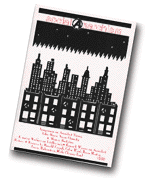Give Peace a Chance
February 08, 2006
Give Peace a Chance — Exploring the Vietnam Antiwar Movement
ed. by Melvin Small and William D. Hoover. 324 pp. Syracuse: Syracuse University Press, 1992. $34.95 cloth, $17.95 paper.
ed. by Melvin Small and William D. Hoover. 324 pp. Syracuse: Syracuse University Press, 1992. $34.95 cloth, $17.95 paper.
Vietnam, its name alone conjures up the most disparate memories, from mass demonstrations and combat news clips through fears of conscription and arcane debates about Trotskyism in Asia to Democratic Party politicking and the lyrics of certain songs. This collection of essays by Melvin Small and William Hoover chronicles some of the detailed events and high drama surrounding that amorphous, exciting phenomenon that was called the antiwar movement. In fact, three of the opening monographs recall the tensions and compromises that went to reconcile pacifists, Marxists, hippies and dissident Democrats in this odd brew. Most everybody who participated in any of the antiwar activities knew there was a simmering conflict between those who "were just against the war" and those who dreamed of some shade of red revolution to come; the sectarian groups fastened on the margins of every demo like leeches literally seeking new blood for their organizations.
This debate went even further at the upper levels, since pacifists contended with those opposed to "this war" and many of the political people, like Tom Hayden, were suspicious of the countercultural types, (hippies), but eager to exploit the mas- sive audiences that the proper amount of style could draw. The suspicions of the politicals were not unfounded; it has been less than a generation since the radical slogans of the counterculture have become marketing cliches. Of course, the "politicals" had their own problems, whether believing Ho Chi-Minh was Santa Claus or an American October Revolution was imminent. Most of the rank-and-file demonstrators knew the war was an outrage and were often willing to explore the limits of political prankishness, yet remained ironically sympathetic, at best, to the groups that had called upon them. The authors of these pieces include participants in the events at various levels of responsibility, like David McReynolds and David Farber, but seem unaware of the agnosticism that motivated the masses they often addressed.
If the shotgun marriage of politics and culture, with the war and draft as a potent catalyst, made for huge outbursts of civil disobedience like the "May Day '71" events when thousands were arrested in Washington DC, the real killing and dying in Southeast Asia soon had its effects in the military. The essays on this subject by combat veterans like William Crandell, Elliot Meyrowitz, Kenneth Campbell and Terry Anderson are among the strongest in the book, since they chronicle the elements of dissent, often brought in by conscripts, that spread slowly but effectively among regulars in all the armed services. They argue persuasively that mutinies on airbases and aboard ships were serious factors in the decision to negotiate a peace. They also note how difficult it was for the local police and patriotic dowagers to discount protests by the decorated and disenchanted veterans of the Second Indo-Chinese War. The current emphasis on a volunteer army may well be the lasting accomplishment of these mostly men who often paid a high price for the legitimacy of their criticism.
The emphasis in the 1960s and 1970s on the war seemed such a masculine issue that the important role played by left-wing and pacifist women was often ignored or belittled. That prejudice eventually fueled the start of the modern feminist movement and sometimes provided the earliest issues: who did the dreary clerical work within organizations and who ended up speaking at rallies, who made coffee and who determined issues. Amy Swerdlow's piece on Women Strike for Peace depicts the women's role in the antiwar movement and notes such embarrassments as the Whitehorn case, in which mother, Evelyn and son, Erik, ironically competed for publicity. But the feminist disillusionment with both the counterculture and Marxist wings was, indeed, deep and widespread as indicated by the rapid growth of new groups and publications. As Alice Echols quotes Shulamith Firestone, the women's movement was sheer dynamite compared to the poor donkey of leftist politics. The later splits within the feminist movement over issues of class, race and pornography were far in the future at the time of the Vietnamese War, but that distant conflict initiated a new generation of feminists, as surely as it disillusioned a nation.
The current waves of campus politics, and apathy is just as strong if less clear a political message, should not blind anyone to the importance of time. Kenneth Heineman's detailed history of anti-war activity on one campus, Kent State, shows the difference five or seven years can make between a small despised minority and a more popular movement. Once again, conscription brought home ever so clearly the cost of world power when it was applied ever so thoughtlessly as in Southeast Asia.
The odd truth of this collection is that the minority of dissenters from the early days of the Vietnamese War, who were quite often well aware of Uncle Ho's less charming aspect, were there to tutor and to counsel the masses of demonstrators who often had only the foggiest ideas of imperialism, pacifism, or socialism. That good advice and often good sense was ignored may have been the privilege of youthful spirits, but as one of the contributors to this volume notes, short tempers and crankiness were not uncommon during this period. This collection, however, displays the advantages of the professional historian's skills when dealing with material that is just distant enough for old passions to have cooled to a concerned interest.
This debate went even further at the upper levels, since pacifists contended with those opposed to "this war" and many of the political people, like Tom Hayden, were suspicious of the countercultural types, (hippies), but eager to exploit the mas- sive audiences that the proper amount of style could draw. The suspicions of the politicals were not unfounded; it has been less than a generation since the radical slogans of the counterculture have become marketing cliches. Of course, the "politicals" had their own problems, whether believing Ho Chi-Minh was Santa Claus or an American October Revolution was imminent. Most of the rank-and-file demonstrators knew the war was an outrage and were often willing to explore the limits of political prankishness, yet remained ironically sympathetic, at best, to the groups that had called upon them. The authors of these pieces include participants in the events at various levels of responsibility, like David McReynolds and David Farber, but seem unaware of the agnosticism that motivated the masses they often addressed.
If the shotgun marriage of politics and culture, with the war and draft as a potent catalyst, made for huge outbursts of civil disobedience like the "May Day '71" events when thousands were arrested in Washington DC, the real killing and dying in Southeast Asia soon had its effects in the military. The essays on this subject by combat veterans like William Crandell, Elliot Meyrowitz, Kenneth Campbell and Terry Anderson are among the strongest in the book, since they chronicle the elements of dissent, often brought in by conscripts, that spread slowly but effectively among regulars in all the armed services. They argue persuasively that mutinies on airbases and aboard ships were serious factors in the decision to negotiate a peace. They also note how difficult it was for the local police and patriotic dowagers to discount protests by the decorated and disenchanted veterans of the Second Indo-Chinese War. The current emphasis on a volunteer army may well be the lasting accomplishment of these mostly men who often paid a high price for the legitimacy of their criticism.
The emphasis in the 1960s and 1970s on the war seemed such a masculine issue that the important role played by left-wing and pacifist women was often ignored or belittled. That prejudice eventually fueled the start of the modern feminist movement and sometimes provided the earliest issues: who did the dreary clerical work within organizations and who ended up speaking at rallies, who made coffee and who determined issues. Amy Swerdlow's piece on Women Strike for Peace depicts the women's role in the antiwar movement and notes such embarrassments as the Whitehorn case, in which mother, Evelyn and son, Erik, ironically competed for publicity. But the feminist disillusionment with both the counterculture and Marxist wings was, indeed, deep and widespread as indicated by the rapid growth of new groups and publications. As Alice Echols quotes Shulamith Firestone, the women's movement was sheer dynamite compared to the poor donkey of leftist politics. The later splits within the feminist movement over issues of class, race and pornography were far in the future at the time of the Vietnamese War, but that distant conflict initiated a new generation of feminists, as surely as it disillusioned a nation.
The current waves of campus politics, and apathy is just as strong if less clear a political message, should not blind anyone to the importance of time. Kenneth Heineman's detailed history of anti-war activity on one campus, Kent State, shows the difference five or seven years can make between a small despised minority and a more popular movement. Once again, conscription brought home ever so clearly the cost of world power when it was applied ever so thoughtlessly as in Southeast Asia.
The odd truth of this collection is that the minority of dissenters from the early days of the Vietnamese War, who were quite often well aware of Uncle Ho's less charming aspect, were there to tutor and to counsel the masses of demonstrators who often had only the foggiest ideas of imperialism, pacifism, or socialism. That good advice and often good sense was ignored may have been the privilege of youthful spirits, but as one of the contributors to this volume notes, short tempers and crankiness were not uncommon during this period. This collection, however, displays the advantages of the professional historian's skills when dealing with material that is just distant enough for old passions to have cooled to a concerned interest.

